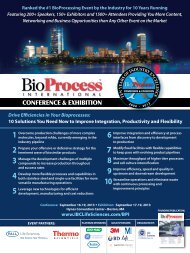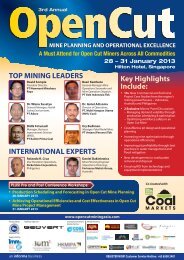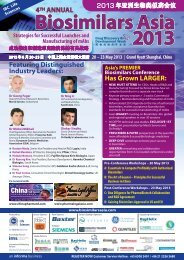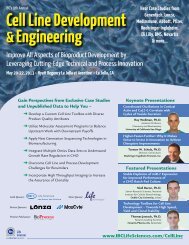EMEA'S PREMIER OPTICAL NETWORKING EVENT
EMEA'S PREMIER OPTICAL NETWORKING EVENT
EMEA'S PREMIER OPTICAL NETWORKING EVENT
- No tags were found...
You also want an ePaper? Increase the reach of your titles
YUMPU automatically turns print PDFs into web optimized ePapers that Google loves.
DAY ONE, TUESDAY 18TH JUNE 2013Economising Next Generation OpticalNetworks & Evolving OTN“This event is really instructive and the presentationsare really thorough. The number and quality ofattendees offer you great opportunities to make new keyacquaintances. If your business involves using DWDM;you MUST be there !” CD, SNCF07.50 Registration and Coffee 08.20 Conference Welcome and Speed NetworkingA chance to get to know your peers before the start of the conference and set a relaxed, informal and friendly atmosphereKEYNOTE: Monetising Next Generation Optical NetworksOPERATOR08.30 Opening Remarks from the ChairAndrew Schmitt, Directing Analyst, Optical, Infonetics, USA08.40 Technology Innovations and Business Transformations;Optical Communications in 2013 and BeyondLeonard Bosack continues to drive technology innovation in his quest to bringTELECOMSVISIONNARYKEYNOTEOTN EVOLUTION STRATEGIES14.20 Integrated OTN Switching Brings Data CentreVirtualisation to Optical Transport Networking• Virtulisation is being extended from data centres to optical transport networks• Benefits of integrated OTN switching include efficient capacity utilisation, quickservice turn-up, policy-based provisioning, and rapid failure restorationAndrew Schmitt, Directing Analyst, Optical, Infonetics14.30 How Mature is OTN Switching Really? Converged OTN & WDM• Supporting a mix of 10G, 40G and 100G channels on the same fibre pair, meaning itcan reuse its embedded optical network infrastructure and expand capacity as needed• Incorporating GMPLS control plane intelligence to ensure network restoration andautomating circuit turn upJimmy Mizrahi, Head of Optical Networking, ECI Telecom14.50 Case Study - 40G Non-Coherent and Plans towards 100GCoherent• Overview of MTN 40G Optical OTN/ROADM network (protection scheme, migrationstrategy, challenges of deployment/operation)OPERATOR• Business Case for 100G deployment (technical challenges, financial consideration)• Recommendation/conclusionsUka Ibe, Team Lead, Transmission Access Planning, Network Group – Transmission,MTN Nigeria15.10 Ethernet Services over OTN• Update from the MetroEthernet Forum on the status of Ethernet services over OTNA Representative, Metro Ethernet Forum15.30 Networking Refreshment Break16.15 OTN and WDM – Packet vs Circuit Switch – What is theright Mix and Why?• Debating why some customers want IP packet switched networks and some wantcircuit switch?• Debating the cost/flexibility relation- OTN switching vs routing on IP Layer?PACKET VS CIRCUITSWITCH DEBATEfundamental change to worldwide telecommunicationsLeonard Bosack co-founded Cisco Systems in 198608.50 Insight into Drivers, Demands and Applications Behindthe Capacity Demand• Discussing the development status of high speed optical communication industryand technology in China• Analysing the bandwidth demand and the trend of the high speed optical network<strong>OPTICAL</strong> NETWORKSUPDATE CHINAOTN SHIPPING &MARKET SHAREDATA REVIEW OPERATORapplication in ChinaHaiyi Zhang, Director, CATR,Ministry of Industry and Information Technology (MIIT), China09.10 Capacity Planning – Make the Best of the Assets youhave & Making them work for you Effectively• Pan European service provider historical view, challenges and solutions• Investing and being economical with your current network whilst planning for futurecapacity demands• Addressing capacity demands from Data Centres and the CloudMattias Fridstrom, CTO, TeliaSonera International Carrier09.30 Optical & IP ConvergenceA Senior Representative, Cisco09.50 Building Next-Generation Transport with a ConvergedMulti-Layer Control Architecture• What are the requirements which heterogeneous services impose on networkbackbones?• What are key technologies that provide a blueprint for transport networks?• How much integration is required across packet, digital and optical layers?Jimmy Mizrahi, Head of Optical Networking, ECI TelecomXavier Clivaz, Senior Network Development Engineer, SwisscomPer Larsson, Senior Network Architect, Optical & Transmission Systems, TDC<strong>OPTICAL</strong> NETWORK CONVERGENCE& SERVICE PROVISIONING16.40 IP and Optical Convergence at the Edge - CombiningMetro-Edge POTS and Highly Automated Access forOptimal Network PerformanceConsidering the unique challenges at the edge of a network when addressing highcapacity services for business, mobile backhaul and data center interconnect• Looking at the latest industry advances in optical access and metro-edge POTS suchas WDM-PON and Carrier Ethernet 2.0• Combining these technology options to provide efficient and scalable plug and playservicesSten Nordell, CTO, Transmode13.30 Networking Lunch17.00 New Network Trends with Optical Transport Networks andIP-Optical-Integration• Discussing network architecture strategies at Deutsche TelekomOPERATOR• How to deliver P-OTN-networksWerner Weiershausen, Chief Architect Packet-Optical Networks, Deutsche Telekom17.20 IP & Optical Convergence - Distributed Optical SwitchingAttempts at true packet-optical convergence have taken many forms - but none havereally delivered on the promise of simplicity, efficiency and cost-reduction. DistributedOptical Switching is the only technology that offers the statistical benefits of packetswitching directly at the optical layer. The technology is already being embraced by theleading carriers in the roll-out of their next generation networks.• What is distributed optical switching and how does it work?• How could it revolutionise the economics of telecoms networks?• Where is it being used today and where will it be most useful in the future?Richard Brandon, Head of Strategy, Intune NetworksOPERATORMULTILAYER CHALLENGES DEBATE17.40 Transport Layer Collapsing – Debating Multilayer ServicesChallenges & Solutions• Discussing the evolution of heterogeneous optical networks: multi-layer, multidomain,multi-technology• How to avoid vendor lock problems for carriers: Which network scenarios will allowfor a vendor-open multi-layer network architecture, where is interoperability neededand how to standardise this?• How to deliver flexibility in the core as scale to 100G?• How to combine layer 2 with optical networking equipment?• Bringing SDN into the discussion – integrating packet and optical aggregation –melding packet and optical technologies under the same control software• Meeting the significant transformations of automation, elasticity, and capital/operational efficiency• Seizing the opportunities provided by the convergence of WDM, OTN and packetbandwidth management and meeting the dynamic demands of emerging cloudarchitecturesWerner Weiershausen, Chief Architect Packet-Optical Networks, Deutsche TelekomGeoff Bennett, Director, Solutions & Technology, InfineraImran Malik, Director Enterprise Service Management, Commercial, Du18.10 End of Day One and Drinks ReceptionSponsored by:19.00• How can transport networks achieve sub-50ms resiliency performance acrossvarious layers?• How can software-defined network technologies help solve technology andbusiness bottlenecks in transport?Geoff Bennett, Director, Solutions & Technology, Infinera10.10 Practical Evolution of Legacy Networks• What are the practical evolution pathways for legacy networks?Veronique Guillot-Common, Head of Transmission Strategy, Networks and Carrier/OPERATORInternational & Backbone Network Factory, Orange Labs Networks & Carriers10.30 Networking Refreshment Break & TechnologyVision Launch11.40 5 Years Evolution Plan for OTE Transport Network• Practical evolution of legacy networks approach• Type of services, capacity demand & pattern, future proof expandability &upgradability vs TCOOPERATOR• Comparison between long-term & mid-term technology choicesPhilippos Arbelias, Head of Transmission Network Division, Network Design &Planning, OTE12.00 Readiness for the Next Generation Optical NetworkPeter Stassar,Technical Director on Optical Technology Standards,Huawei European R&D Center12.20 Assisting Service Providers to Modernise their LegacyEnd-of-Life Networks while Enabling New RevenueStreams• Economic return is the ultimate measurement of network value. Operators arefacing an explosion in bandwidth demands, eroding revenue per bit, and intensecompetition from over-the-top applications and content providers. Operators needto transform their legacy network into a cost efficient, agile, flexible platform fordelivering increasingly virtualised services. In this session you will see:• How practical, controlled network modernisation can enhance the network anddeliver return on investment while enabling new revenue streams“I thought the conference wasgreat and I am putting in mybudget for next year tocome again” EIGENLIGHT• How scaling is enabled by minimising complex locations, converging devices andlayers, and simplifying forwarding• How network-level applications are enabled by rapid service creation, networkanalytics, and open interfaces - leading to maximum revenue growthMervyn Kelly, Marketing Director, Ciena12.40 Defining Optical Transport Architectures for the Cloud• Investigating unique transport network requirements for the cloud and how thesecan best be addressed with existing and emerging optical technologies• How are Cloud applications and convergence, along with changing businessmodels driving Service Provider technology choices?• Cloud centric IP networks: Which optical network architectures are the optimummatch, which demands have to be fulfilled?Kevin Drury, Director of Optics Product Marketing, Networks Division, Alcatel-Lucent13.00 What kind of Transport Network Architectures areneeded to Support the Business Changes that ServiceProviders are Demanding?• What are the most significant technological innovations in the optical transport space?• How will switching evolve? Will it be ROADMs, OTNs, packet switching?• How can service providers scale capacity without an army of network engineers?• Will new architectures really lower costs?• How do service providers make money – revenues aren’t going up and costs todeploy are increasing?• Open architecture – how and why?• How to deal with the evolution of legacy networks?Mirko Voltolini, Director Network Design & Architecture, COLTCTO OPERATOR PANEL DISCUSSIONMichael Enrico, CTO, DanteWerner Weiershausen, Chief Architect Packet-Optical Networks,Deutsche TelekomMattias Fridstrom, CTO, TeliaSonera International Carrier“I’m delighted with the conference, 80+ differentservice providers from 50+ countries is a fantasticgroup for us to be able to network with” CISCO14:20 Chair’s opening remarksDaryl Inniss, VP & Practice Leader, OvumNEXT GENERATION ROADM & THE FLEXIBLE GRID14:30 Understanding the operator challenges associated withNGROADM:• What is the reality of implementation for end-users?• Are Tier 1 NGROADM requirements different from Tier 2 and 3 operators? Ifdifferent, do they converge over time?• Is this just a challenge for Tier 1 operators? Or are Tier 2 & 3 operators ready forthem, if it even matters to them?• Are there new & unique opportunities for ROADMs in datacentres?• Do we need ROADMs that can add/drop super-channels and what are their requirements• Utilising a higher number of WSS ports:--Supporting multiple and future modulation schemes for different filter widths--Enabling quick & inexpensive methods of fulfilling the demand for highertransmission speeds--What is the challenge in connecting a higher number of ports?--Cost efficient implementation of tributary side: MxN, WSS, Multicast switches,amplification, optical channel monitoring etc.• Supporting Colourless, Directionless & Contentionless (CDC) functionality--Optimising the combined value of electrical and optical switch fabrics.--Enabling transponders to transmit any wavelength in any direction.• ROADM Architectures:--Is an evolution of Broadcast-and-select really necessary for the future of highspeed technologies?• The monster problem: Flexi-grid capabilities & elastic control plane:--What capabilities are really needed? Ie. Min/max frequency slot, granularity,attenuation profile etc--How does the specification of optical components assist cost-efficient implementation?--How can problems such as network fragmentation be solved?15:30 Networking Refreshment Break<strong>OPTICAL</strong> & THE DATACENTRE16:15 Addressing increased optical networking demandscreated by on-going development of large-scaleGreenfield datacentres for multi-tenant, carrier andprivate use• What do DC vendors require from the optical component manufacturers to addresstheir current challenges in connectivity, traffic prioritisation and data transfer speeds?• How are inter and intra datacentre line rates expected to evolve or scale in the future?• What does the future of 400GB or 1TB Ethernet hold in this regard?• Will standardisation measurements come in in-time to match customer requirements?18:15 Chair’s Closing Remarks18:30 End of Day OneTo register please call + 44 (0)20 7017 7483 or e-mail registrations@iir-telecoms.com
















